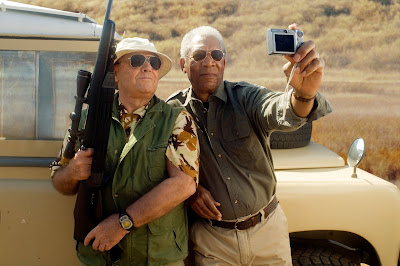 by Tony Dayoub
by Tony DayoubAvailable tomorrow on DVD, Shotgun Stories is one of the best films of 2007. Produced by indie stalwart David Gordon Green (George Washington), first-time director Jeff Nichols' film resembles some of the quiet, rural stories Green has such an affinity for. Green has cited Terrence Malick (Badlands) as a major influence in his work, and one can see (evident in this photo) the lineage extends on to Nichols' accomplished but little seen film.
The film follows two sets of half-brothers through an escalating feud. Sparked by the intrusion of the first set of brothers to their late dad's funeral, and some unflattering remarks made about the deceased in front of the second set of brothers, the resentment builds easily between them. The late born-again father abandoned his first set of kids, leaving them with a bitter mother who taught them to hate the new family.
Michael Shannon (Bug) plays Son Hayes, the laconic and protective eldest of the first set of brothers. Estranged from his wife, who left with their son, he still holds a grudge over the rudderless life he blames his father for. Shannon never telegraphs what his character will do, playing him as a hollow man who probably isn't even aware of what his next move will be. This aids tremendously in keeping the film's story unpredictable.
The screenplay is economical and filled with pregnant pauses that ratchet up the tension. We are never subjected to expository dialogue, but the blanks are always effectively filled in for us. We are able to get a sense of the type of man his father was by the throwaway names the formerly deadbeat father gave his first set of children, Son's younger siblings being named Boy and Kid. A growing sense of doom pervades every exchange in the film. When Boy and Kid walk towards a basketball court, and a car swerves into frame behind them, you fret that it may be their half-brothers looking for a fight. As Son stands with his family at the local car wash, and you see the half-brothers pull in provocatively, you dread that his young son came along for this errand.
The movie unfolds leisurely, but you never feel less than riveted by the story. As a character piece it is stunning, each player distinctly unique in his/her own way, but each a product of their rural surroundings. They have limited aspirations but unlimited imaginations. Boy (Douglas Ligon) lives in a van, to save money, and is constantly tinkering with an air conditioning unit he hopes to hook up to the van. He also coaches a local school's basketball team, and whiles away his free time with Kid on basketball trivia.
A great movie for a weekend afternoon, Shotgun Stories is a small gem that should not be missed.














